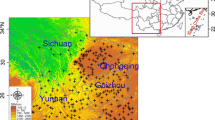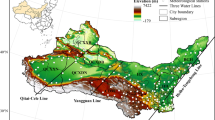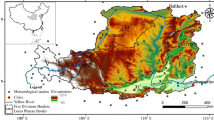Abstract
Reference crop evapotranspiration (ETo) is one of the most important links in hydrologic circulation and greatly affects regional agricultural production and water resource management. Its variation has drawn more and more attention in the context of global warming. We used the Penman-Monteith method of the Food and Agriculture Organization, based on meteorological factors such as air temperature, sunshine duration, wind speed, and relative humidity to calculate the ETo over 46 meteorological stations located in the Yangtze River Delta, eastern China, from 1957 to 2014. The spatial distributions and temporal trends in ETo were analyzed based on the modified Mann-Kendall trend test and linear regression method, while ArcGIS software was employed to produce the distribution maps. The multiple stepwise regression method was applied in the analysis of the meteorological variable time series to identify the causes of any observed trends in ETo. The results indicated that annual ETo showed an obvious spatial pattern of higher values in the north than in the south. Annual increasing trends were found at 34 meteorological stations (73.91 % of the total), which were mainly located in the southeast. Among them, 12 (26.09 % of the total) stations showed significant trends. We saw a dominance of increasing trends in the monthly ETo except for January, February, and August. The high value zone of monthly ETo appeared in the northwest from February to June, mid-south area from July to August, and southeast coastal area from September to January. The research period was divided into two stages—stage I (1957–1989) and stage II (1990–2014)—to investigate the long-term temporal ETo variation. In stage I, almost 85 % of the total stations experienced decreasing trends, while more than half of the meteorological stations showed significant increasing trends in annual ETo during stage II except in February and September. Relative humidity, wind speed, and sunshine duration were identified as the most dominant meteorological variables influencing annual ETo changes. The results are expected to assist water resource managers and policy makers in making better planning decisions in the research region.










Similar content being viewed by others
References
Allen RG (2000) REF-ET, reference evapotranspiration calculator version Windows 2.0. User’s manual. University of Idaho Research and Extension Center, Kimberly, ID
Allen RG, Pereira LS, Raes D, Smith M (1998) Crop evapotranspiration: guideline for computing crop water requirement. FAO irrigation and drainage paper no. 56. Food and Agriculture Organization, Italy
Bandyopadhayay A, Bhadra A, Raghuwanshi NS, Singh R (2009) Temporal trends in estimates of reference evapotranspiration over India. J Hydrol Eng 14(5):508–518
Blaney HP, Criddle WD, Blaney HF, et al. (1950) Determining water requirements in irrigated areas from climatological and irrigation data. In: Tech Paper 96. USDA Soil of Conservation Service. The Conterminous United States. Colorado State University, Fort Collins, CO
Burn DH, Hesch NM (2007) Trends in evaporation for the Canadian prairies. J Hydrol 336(1–2):61–73
Chen X, Liu X, Zhou G, Han L, Liu W, Liao J (2015) 50-year evapotranspiration declining and potential causations in subtropical Guangdong province, southern China. Catena 128:185–194
Chi Y, Zhang C, Liang C, Wu H (2013) The precipitation changes in eastern forest regions of China in recent 50 years. Acta Ecol Sin 33:217–226
Chun KP, Wheater HS, Onof C (2012) Projecting and hind casting potential evaporation for the UK between 1950 and 2099. Clim Chang 113:639–661
Cristea NC, Kampf SK, Burges SJ (2012) Linear models for estimating annual and growing season reference evapotranspiration using averages of weather variables. Int J Climatol 33(2):376–387
Croitoru AE, Piticar A, Dragota CS, Burada DC (2013) Recent changes in reference evapotranspiration in Romania. Glob Planet Chang 111:127–132
Dinpashoh Y, Jhajharia D, Fajheri-Fard A, Singh VP, Kahya E (2011) Trends in reference crop evapotranspiration over Iran. J Hydro 399:422–433. doi:10.1016/j.jhydrol.2011.01.021
Feng J, Yan D, Li C, Yu F, Zhang C (2014) Assessing the impact of climatic factors on potential evapotranspiration in droughts in North China. Quatern Int 336:6–12
Gao G, Chen D, Ren G, et al. (2006) Trend of potential evapotranspiration over China during 1956 to 2000. Geographic Res 25(3):378–387 in Chinese
Goyal RK (2004) Sensitivity of evapotranspiration to global warming: a case study of arid zone of Rajasthan (India. Agric Water Manag 69(1):1–11
Jhajharia D, Shrivastava SK, Sarkar D, Sarkar S (2009) Temporal characteristics of pan evaporation trends under the humid conditions of northeast India. Agric For Meteorol 149:763–770
Jones DA, Wang W, Fawcett R (2009) High-quality spatial climate data-sets for Australia. Aust Meteorol Ocean 58(4):233–248
Kendall MG (1975) Rank correlation methods. Griffin, London
Lawrimore JH, Peterson TC (2000) Pan evaporation trend in dry and humid regions of the United States. J Hydrometeorol 1(6):543–546
Liang LQ, Li LJ, Liu Q (2010) Temporal variation of reference evapotranspiration during 1961-2005 in the Taoer River basin of Northeast China. Agric For Meteorol 150(2):298–306
Lins HF, Slack JR (2005) Seasonal and regional characteristics of US stream flow trends in the United States from 1940 to 1999. Phys Geogr 26(6):489–501
Liu Q, Yang Z (2010) Quantitative estimation of the impact of climate change on actual evapotranspiration in the Yellow River Basin, China. J Hydrol 395:226–234
Liu Q, Yang Z, Cui B, Sun T (2010) The temporal trends of reference evapotranspiration and its sensitivity to key meteorological variables in the Yellow River Basin, China. Hydrol Process 24(15):2171–2181
Ma XN, Zhang MJ, Li YJ, Wang SJ, Ma Q, Liu WL (2012) Decreasing potential evapotranspiration in the Huanghe River watershed in climate warming during 1960–2010. J Geogr Sci 22(6):977–988
Mann HB (1945) Nonparametric tests against trend. Econometrica 13(3):245–259
Monteith JL (1965) Evaporation and environment. Symp Soc for Exp Biol 19:205–234
Nam W, Hong E, Choi J (2015) Has climate change already affected the spatial distribution and temporal trends of reference evapotranspiration in South Korea? Agric Water Manag 150:129–138
Ozdogan M, Salvucci GD (2004) Irrigation-induced changes in potential evapotranspiration in southeastern Turkey: test and application of Boucher’s complementary hypothesis. Water Resour Res 40(4). doi:10.1029/2003WR002822
Penman HL (1948) Natural evaporation from open water, bare soil and grass. Proc R Soc Lond 193:120–145
Price DT, McKenny DW, Nalder IA, Hutchinson MF, Kesteven JL (2000) A comparison of two statistical methods for spatial interpolation of Canadian monthly mean climate data. Agric For Meteorol 101:81–94
Priestley CH, Taylor RJ (1972) On the assessment of surface heat flux and evaporation using larger-scale parameters. Mon Weather Rev 100(2):81–92
Ren GY, Guo J, Xu ZM, Chu ZY, Zhang L, Zou XK, Li QX, Liu XN (2005) Climate change of China’s mainland over the last half century. Acta Meterol Sin 63:942–956 in Chinese
Roderick ML, Farquhar GD (2004) Changes in Australian pan evaporation from 1970 to 2002. Int J Climatol 24(9):1077–1090
Roderick ML, Rostayn LD, Farquhar GD, Hobbins MT (2007) On the attribution of changing pan evaporation. Geophys Res Lett 34(17):403. doi:10.1029/2007GL031166
Sahoo D, Smith PK (2009) Hydro climatic trend detection in a rapidly urbanizing semi-arid and coastal river basin. J Hydrol 367:217–224
Shan N, Shi Z, Yang X, Gao J, Cai D (2015) Spatiotemporal trends of reference evapotranspiration and its driving factors in the Beijing–Tianjin Sand Source Control Project Region, China. Agric For Meteorol 200:322–333. doi:10.1016/j.agrformet.2014.10.008
Streets DG, Yu C, Wu Y, Chin M, Zhao ZC, Hayasaka T, Shi GY (2008) Aerosol trends over China, 1980–2000. Atmos Res 88(2):174–182
Tang B, Tong L, Kang SZ, Zhang L (2011) Impacts of climate variability on reference evapotranspiration over 58 years in the Haihe river basin of North China. Agric Water Manag 98:1660–1670
Tayanc M, Karaca M, Yenigun O (1997) Annual and seasonal air temperature trend patterns of climate change and urbanization effects in relation to air pollutants in Turkey. J Geophys Res 102(D2):1909–1919
Thomas A (2000) Spatial and temporal characteristics of potential evapotranspiration trends over China. Int J Climatol 20:381–396
Thornthwaite CW (1948) An approach toward a rational classification of climate. Geographic Rev 38:55–94
Wang W, Peng S, Yang T, Shao Q, Xu J, Xing W (2011) Spatial and temporal characteristics of reference evapotranspiration trends in the Haihe River basin, China. J Hydrol Eng 16(3):239–252
Xu CY, Gong LB, Jiang T, Chen DL, Singh VP (2006) Analysis of spatial distribution and temporal trend of reference evapotranspiration and pan evaporation in Changjiang (Yangtze River) catchment. J Hydrol 327:81–93
Yang Y, Zhang Z, Xiang X (2009) Spatial variation of reference crop evapotranspiration on Tibetan Plateau. Water. Sci Eng 2(1):112–120
Yang JY, Liu Q, Mei XR, Yan CR, Ju H, Xue JW (2013) Spatiotemporal characteristics of reference evapotranspiration and its sensitivity coefficients to climate factors in Huang-Huai-Hai Plain, China. J Integr Agric 12(12):2280–2291
Yin YH, Wu SH, Dai EF (2010) Determining factors in potential evapotranspiration changes over China in the period 1971–2008. Chin Sci Bull 55(29):3329–3337. doi:10.1007/s11434-010-3289-y
Yue S, Wang C (2004) The Mann-Kendall test modified by effective sample size to detect trend in serially correlated hydrological series. Water Resources Manag 18:201–218
Zhang X, Harvey KD, Hogg WD, Yuzyk TR (2001) Trends in Canadian stream flow. Water Resources Res 37(4):987–998
Zhang X, Kang S, Zhang L, Liu J (2010) Spatial variations of climatology monthly crop reference evapotranspiration and sensitivity coefficients in Shiyang river basin of northwest China. Agr. Water Manage 97:1506–1516
Zhang Q, Xu C, Chen X (2011a) Reference evapotranspiration changes in China: natural processes or human influences? Theor Appl Climatol 103:479–488
Zhang Q, Xu C, Chen YD, Ren L (2011b) Comparison of evapotranspiration variations between the Yellow River and Pearl River basin, China. Stoch Environ Res Risk Assess 25:139–150
Zhang Q, Qi T, Li J, Singh VP, Wang Z (2015) Spatiotemporal variations of pan evaporation in China during 1960–2005: changing patterns and causes. Int J Climatol 35:903–912
Zhao Y, Zou X, Zhang J, Cao L, Xu X, Zhang K, Chen Y (2014) Spatio-temporal variation of reference evapotranspiration and aridity index in the Loess Plateau Region of China, during 1961-2012. Quatern. Int. 349:196–206
Acknowledgments
This research was funded by the National Key Research and Development Plan of China (No. 2016YFC0401502), National Natural Science Foundation of China (No. 41371046), Commonweal and Specialized Program for Scientific Research, Ministry of Water Resources of China (No. 201201072), the Natural Science Foundation of Jiangsu Province (No. BK20131276), and the Water Conservancy Science Foundation of Jiangsu Province (No. 2015003). Thanks to the National Meteorological Information Center, China Meteorological Administration for offering the meteorological data. The authors would like to thank the two anonymous reviews and editor for their constructive criticism and valuable comments to improve the quality of the manuscript.
Author information
Authors and Affiliations
Corresponding author
Rights and permissions
About this article
Cite this article
Xu, Y., Xu, Y., Wang, Y. et al. Spatial and temporal trends of reference crop evapotranspiration and its influential variables in Yangtze River Delta, eastern China. Theor Appl Climatol 130, 945–958 (2017). https://doi.org/10.1007/s00704-016-1928-1
Received:
Accepted:
Published:
Issue Date:
DOI: https://doi.org/10.1007/s00704-016-1928-1




